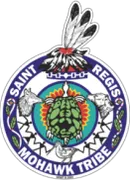Habitat Restoration Will Provide Benefits to Region
The Saint Regis Mohawk Tribe does not agree with the U.S. Environmental Protection Agency’s (EPA) proposed plan to clean up the Grasse River. “We appreciate EPA’s recognition of the Indian Meadows as reservation lands and the recognition of our status as an Environmental Justice community because of the disproportionate impact on this community from the contamination of the Grasse River. But we do not totally agree with their cleanup plan,” remarked Ken Jock, Director of the tribe’s Environment Division. “We do support dredging of the entire near shore area of the Grasse River -- everything along the banks to five feet in depth.”
Past industrial activity from the Alcoa West facility contaminated the Grasse River with polychlorinated biphenyls (PCBs), which are found in hydraulic fluids. Other hazardous substances were also released and approximately seven miles of the Grasse River have been contaminated. As a result, these chemicals have built up in the food chain and affected the fish and wildlife associated with the river. The consumption of local fish has had well-documented adverse health effects on the Saint Regis Mohawk Tribe. The tribe is proposing a more pro-active approach to the remediation of the Grasse River.
“Capping is not a permanent remedy and ice scour is a constant threat to any cap in the Grasse River,” said Ken Jock. “Therefore we do not support the capping of the highly contaminated sediments in main channel,” he added. “Nobody has any real-world evidence that a cap can withstand a major ice jam and ice scour.” The pilot studies conducted about capping showed that they were not successful in achieving a uniform capping layer. The problem is worse here because it is in a dynamic river with spring ice jams, floods, scour and erosion.
The tribe is looking to remediate the river to be able to restore the habitat and achieve a safe fishery in the Grasse River. “This would not only benefit the Saint Regis Mohawk Tribe, it would benefit the entire region,” noted Randy Hart, Tribal Chief. “Both the local and downstream areas would be improved.” Habitat restoration would allow people to consume fish, trap and gather plants that grow near the water.
“We do not support the capping of the main channel’s highly contaminated sediments just as we do not support a cap over the GM dump,” explained Tribal Chief Ron LaFrance. “The cap in the river would leave about 93 percent of the contaminated sediments in the river bottom.”
The EPA will hold local public meetings to discuss its plan. They will hold two meetings in Akwesasne on October 29, 2011: a public information session at the St. Regis Mohawk School from 1:00 p.m. to 3:00 p.m. and a public meeting at the seniors’ center from 7:00 p.m. to 9:00 p.m. They will also hold two meetings in Massena on October 30, 2012: a public information session at the Massena Town Hall from 1:00 p.m. to 3:00 p.m. and a public meeting also at the Massena Town Hall from 7:00 p.m. to 9:00 p.m. The EPA encourages the public to comment on the plan through November 15, 2012. Written comments on the proposed plan may be mailed or emailed to: Young S. Chang, Remedial Project Manager, U.S. EPA, 290 Broadway, 20th floor, New, NY 10007-2866 or email: chang.young@epa.gov. Phone number is 212-637-3966.
Please direct media inquiries to David T. Staddon, Public Information Director at 518-358-2272, ext. 286.
Download EPA press release: EPA Releases Plan to Address PCB Contamination in the Grasse River in Massena, New York - Public Urged to Submit Comments No Later Than November 15

